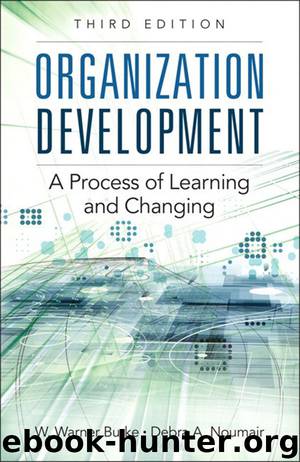Organization Development: A Process of Learning and Changing by W. Warner Burke & Debra A. Noumair

Author:W. Warner Burke & Debra A. Noumair
Language: eng
Format: mobi
Publisher: Pearson Education
Published: 2015-01-12T14:00:00+00:00
Criteria for Effective Intervention
Argyris (1970) has specified similar criteria for what he considers the primary tasks of an interventionist (OD practitioner). His three criteria are (1) valid and useful information, (2) free choice, and (3) internal commitment. By valid and useful information, he means “that which describes the factors plus their interrelationships, that create the problem for the client system” (p. 17). According to Argyris, the information the OD practitioner has collected from and about the client accurately reflects what people in the organization perceive and feel, what they consider to be their primary concerns and issues, what they experience as complexities and perhaps accompanying frustrations of living within and being a part of the client system, and what they would like to see changed. Argyris goes on to specify that, if several independent diagnoses lead to the same intervention, the data the practitioner has gathered are valid.
For all practical purposes, this first task of an interventionist, obtaining valid and useful information, is similar to our first criterion for intervention, responding to an actual and felt need for change on the part of the client. If valid information is obtained by the practitioner, it will reflect a need. If the practitioner responds to that need, he or she will have done so by providing valid and useful information.
By free choice, Argyris means that “the locus of decision making [is] in the client system” (p. 19) and that the client is provided alternatives for action. No particular or specified action is automatic, preordained, or imposed.
By internal commitment, Argyris means that the client owns the choice made and feels responsible for implementing it. Organization members act on their choice because it responds to needs, both individual and on behalf of the organization.
The primary tasks of choice and internal commitment will be accomplished if the practitioner involves the client in planning and implementing the intervention. Argyris does not specify cultural change, our third criterion. He implies that, if the practitioner accomplishes the three primary tasks, the organization’s culture will be changed. This is only an implication, however; he does not specify it.
Although there are similarities between Argyris’s criteria and ours, the primary difference is that we are expressing processes or means while he is stating end states or outcomes. Either way of expressing these criteria makes sense.
Download
This site does not store any files on its server. We only index and link to content provided by other sites. Please contact the content providers to delete copyright contents if any and email us, we'll remove relevant links or contents immediately.
Bad Blood by John Carreyrou(6275)
Rich Dad Poor Dad by Robert T. Kiyosaki(6176)
Principles: Life and Work by Ray Dalio(5961)
Playing to Win_ How Strategy Really Works by A.G. Lafley & Roger L. Martin(5500)
Management Strategies for the Cloud Revolution: How Cloud Computing Is Transforming Business and Why You Can't Afford to Be Left Behind by Charles Babcock(4438)
The Confidence Code by Katty Kay(4039)
Thinking in Bets by Annie Duke(3996)
American Kingpin by Nick Bilton(3508)
Delivering Happiness by Tony Hsieh(3283)
Project Animal Farm: An Accidental Journey into the Secret World of Farming and the Truth About Our Food by Sonia Faruqi(3018)
The Power of Habit by Charles Duhigg(2966)
Brotopia by Emily Chang(2897)
Mastering Bitcoin: Programming the Open Blockchain by Andreas M. Antonopoulos(2891)
The Tyranny of Metrics by Jerry Z. Muller(2847)
I Live in the Future & Here's How It Works by Nick Bilton(2844)
The Marketing Plan Handbook: Develop Big-Picture Marketing Plans for Pennies on the Dollar by Robert W. Bly(2795)
The Content Trap by Bharat Anand(2778)
Building a StoryBrand by Donald Miller(2754)
Applied Empathy by Michael Ventura(2752)
